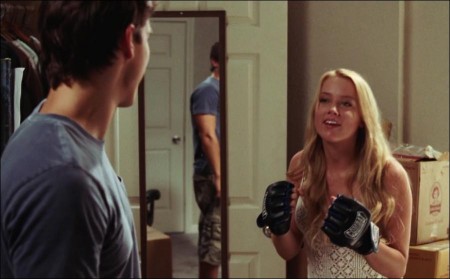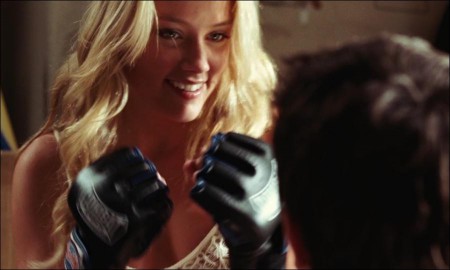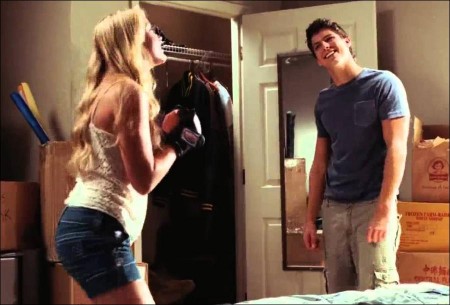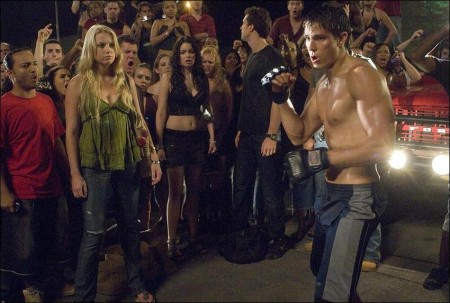Set against the action-packed world of Mixed Martial Arts, Never Back Down is the story of Jake Tyler, a tough kid who leads with his fists, and, often, with his heart. Jake Tyler, played by Sean Faris, is the new kid in town with a troubled past. He has recently moved to Orlando, Florida with his family who has relocated to support his younger brother’s shot at a professional tennis career. Jake was a star athlete on the football team at home, but in this new city he is an outsider with a reputation for being a quick tempered brawler.
Making an attempt to fit in, at the invitation of a flirtatious classmate, Baja (Amber Heard), Jake goes to a party where he is unwittingly pulled into a fight with a bully named Ryan McDonald (Cam Gigandet). While he is defeated and humiliated in the fight, a classmate introduces himself to Jake and tells him about the sport known as Mixed Marshall Arts (MMA). He sees a star in Jake and asks that he meet with his mentor, Jean Roqua, played by Djimon Hounsou (Blood Diamond, In America).
It is immediately apparent to Jake that MMA is not street fighting, but rather an art form he wants to master. Roqua will take Jake under his wing, but it is up to Jake to find the patience, discipline, willingness and reason within him to succeed. For Jake, there is much more at stake than mere victory. His decision will not just settle a score; it will define who he is.
Detailed Storyline
Orlando, Florida may as well be the moon for Iowa-native Jake Tyler (Sean Faris) with its ten-million dollar mansions set ten feet apart. The privileged teenagers of this American Dream on steroids want for nothing; they zoom around upscale neighborhoods in expensive cars, wearing bikinis and flip-flops, affecting the jaded ennui of kids with too much, too soon. Life is one big party for them.
Jake was a star athlete on the football team back home, but in this new city he is an outsider. Considered “the new kid” with his taciturn attitude and lumberjack attire, Jake’s not winning friends anytime soon, and that’s OK with him. Quiet and withdrawn, he’s silently suffering from the recent loss of his father. It’s not long, however, before Jake’s troubled past re-emerges when a clip of a spectacular football-field fist fight from Iowa is forwarded around his new school.
Things take a turn when he meets Baja (Amber Heard) in class. She’s beautiful-and smarter than she lets on. At her invitation, Jake goes to a party where he is unwittingly pulled into a fight with a bully named Ryan McCarthy (Cam Gigandet). He is defeated and humiliated in the fight and subsequently wary of everyone, especially Baja, who may have set him up. But it’s Jake’s enthusiastic, good-hearted classmate Max (Evan Peters), who sees a champion in Jake. He tells Jake about the sport known as mixed martial arts (MMA) and invites him to meet with his coach, Jean Roqua (Djimon Hounsou).
It is immediately apparent to Jake that MMA is not street fighting, but rather an art form he’s determined to master. Roqua will take Jake under his wing, but it is up to Jake to find the patience, discipline and motivation to succeed. For Jake, there is much more at stake than mere victory. His decision will not just settle a score; it will define who he is.
About The Production
Producer Craig Baumgarten knew immediately after reading the script that “…it was a great idea for a movie. I met with screenwriter Chris Hauty and we hit it off. I then asked (producer) David Zelon to get involved as he had a lot of knowledge and experience in the MMA world.”
Never Back Down was an ambitious undertaking for young director Jeff Wadlow. The film featured huge fight scenes populated by hundreds of extras, and it was punctuated by the intimate dynamics of a family in crisis and a young man’s struggle to make peace with his past. There were intricate, fast-paced MMA sequences coupled with the character-driven relationship between the master fighter and mentor Jean Roqua and his truculent student Jake. And the shooting schedule included both long days and nights, filmed in Florida’s grueling summer humidity.
In fact, the emotional and physical facets of the film drew Wadlow to the project and made all the other challenges worthwhile. “I immediately connected to the emotional story of Jake Tyler,” Wadlow says. “Here’s a guy who lost his dad and deals with that trauma by lashing out at the world. Of course, the tragic irony is that more than ever he needs a strong paternal figure to teach him an important lesson: It’s not just him; everyone struggles in life, and it’s our responsibility to make the best of every situation. He learns this lesson from the mixed martial arts instructor Jean Roqua, and I had this feeling that seeing Jake grow emotionally, as he improves physically, could be really compelling.
“The second reason I was attracted to the project was the opportunity to shoot fight scenes in a way that’s never been done before,” Wadlow continues. “The fighting style used in the film is MMA, which is a combination of many different techniques. MMA is the fastest growing sport in the country right now and is quickly eclipsing boxing in popularity. While MMA has been depicted on screen a few times before, it’s never been done in a way that puts you inside the fight. I thought if I could do that for MMA-if I could really show all the details, strategy that these guys employ-I might be able to make the audience feel like they were actually in an MMA fight.”
Casting the male leads initially posed what Wadlow calls “a major dilemma. “Were we going to cast guys who could fight or guys who could act? Ultimately we decided to go for both-and we could not have been luckier. Sean Faris and Cam Gigandet each walked into the room and won the parts on their acting chops alone. But to be safe we took them into the gym, to see what they could do. We were blown away. Not only were they incredible actors, but they also had the physical ability to fight and learn quickly. This was very important, because they had to immediately go to work full time. From weight training, to fight choreography, to stretching and nutrition, we worked those guys so hard in prep they were counting the days till production began so they could get a break!”
Like Wadlow, Faris says the script resonated with him on several levels and in portraying the character of Jake, Faris discovered that he too had to choose to adjust his outlook.
“I loved the script and I loved the idea of training in MMA,” Faris says. “When you first meet Jake, he’s angry at the world and blames himself for everything. We all have those emotions on any given day, but he couldn’t let them go. To play that, sometimes I took it home with me and would be in a bad mood, but really, it’s all about pushing through it and seeing the good in life, because we don’t have control over everything that happens. I had to realize that I had control over my mood. I had to make a choice to have a good day when I left work.”
Rounding out the cast of young actors are Amber Heard and Evan Peters, who play Baja and Max. As it turns out, Heard’s initial reading convinced Wadlow not only to cast her but to take the character in a slightly different direction.
“With Baja, I wanted to find someone who you would believe made the mistake of going with the flow, someone who wasn’t true to herself and as a result, ended up with the wrong guy (Ryan),” Wadlow says. I had always assumed that Baja didn’t really know that Ryan was such a bad guy until she saw him brutalize Jake. But when Amber read for the role, even though she looked stunning, I could see this sadness in her eyes and it suddenly dawned on me that it would be a much more interesting choice if Baja already knew Ryan was a bad guy and it wasn’t until she met Jake that she had the courage to end the relationship. I’m sure even our very talented writer, Chris Hauty, would agree that the character of Baja was not fully realized until we cast Amber.”
Evan Peters, Wadlow says, managed to bring both humor and pathos to his part, something that made Max more than the one-dimensional comical sidekick. “With Max, I knew we needed someone funny, but I was petrified we would just end up with a clown. The kind of guy you would laugh at, but never really care about. Even though Evan was hilarious (I would watch his audition online whenever I needed a laugh), it was his sincerity that got him the part. You just got the impression that he really cared about MMA and his buddy Jake. While Evan’s genuine passion for life makes Max likeable, I believe it’s the authentic friendship he conveys on screen that makes the final battle with Ryan worth fighting,” says Wadlow.
For the role of the master fighter, Jean Roqua, Wadlow says, “… there was only one actor we ever considered seriously: Djimon Hounsou.
“It was of the utmost importance to me that there was nothing mystical about Roqua. There are no hokey ancient karate lessons to be learned in this story, it’s about the physical world and how to exist in it. I think that’s why MMA is so popular … it’s a very practical sport. If your opponent is a striker, you want to take him to the ground. If he’s trying to roll you into a submission hold, you’ve got to counter. It’s this down-to-earth approach to fighting that Roqua embodies, so if he’s going to inspire Jake to do anything, he’s got to be able to do it himself. The only actor I’ve ever seen who can convey that kind of wisdom and posses that kind of physical prowess is Djimon Hounsou, hands down. Without him, the movie could not have been made.”
Two-time Academy Award® nominee Hounsou, who cast a wary eye on Wadlow at first, has nothing but praise for the young director.
“I’ve had the luxury of working with great directors on all sorts of films,” Hounsou says. “I’m always skeptical of a new director, but Jeff definitely has it. He knows what he wants. He’s got a specific vision that he invites you to share, and that’s the most important thing.”
Hounsou is very clear on why he chose to do this movie. He felt that there was a message to send out to audiences, particularly to young people.
“Some kids are just completely lost,” he says, bemoaning a general lack of parental supervision. “Martial Arts schools like the one Roqua runs are valuable in keeping kids off the street and in educating them to develop their bodies and minds. The character Roqua also stresses that it’s important that martial arts is to be used only as a sport or for self-defense, which I thought was important.”
“This story does not advocate violence whatsoever,” adds Faris. “There’s a lesson learned by my character. At first, he’s filled with anger and hate and has an appetite for destruction. He wants to destroy anything that he feels insecure about. As he gains confidence, he wants to continue his training because it provides not only an outlet for his frustration but also a path towards becoming the best person that he can. He doesn’t want to fight anymore to settle a score. That’s an important lesson for him.”
The actors underwent an extremely rigorous pre-production training by stunt and fight coordinators Damon Caro and Jonathan Eusebio, some of whose films include 300, The Bourne Supremacy, The Bourne Ultimatum, Live Free or Die Hard, Mr. & Mrs. Smith, Spider-Man 3, Fight Club, and S.W.A.T. There are fights throughout the movie. Caro and Eusebio were charged with keeping the action exciting while maintaining the believability of the storyline and keeping the moves cinematic. They also invested months in preparing and keeping the actors toned and capable of performing their stunts on screen. Training began about eight weeks before the cameras rolled, and the actors were put through the rigors of MMA.
“Mixed martial arts is exactly what that sounds like-a mixture of kickboxing, grappling, throwing, elbowing and kneeing. It takes moves and formats from wrestling, jiu jitsu, karate, sambo, muay-thai, all sorts of disciplines,” says Caro. “Most people who come to the sport either have a striking, jiu jitsu or wrestling background so they have proficient skills in one method and work towards including and blending the others.”
Caro points out that a movie star played a large part, not just in popularizing martial arts but in breaking down the barriers between the disparate disciplines, paving the way for MMA.
“Martial arts first began to attract wide attention in the 1950s, through karate, judo or kung fu-and they remained very separate. It was almost like a religion-people who trained in Karate did not cross over into judo. Your master would have disowned you. Bruce Lee was a huge influence in breaking down that mindset. In his movies, in the 1970s, he would mix methods and piss everyone off. Fighters would challenge him and they’d end up either walking away with their teeth in their hands or the attitude of, wow, it’s actually working. So, little by little, those barriers came down,” Caro says.
Though Faris and Gigandet were athletic and in good shape, they still had to endure strict nutritional programs and learn how to safely and authentically perform the complicated movements of this popular sport. While Faris had played an athlete on screen before, he was a complete novice to MMA.
“We did about three and a half hours of MMA training everyday,” he says. “I had never done any martial arts before. I learned tae kwon do, jiu jitsu, muay-thai, wrestling, all different types. And then we would have an hour and a half of weight training, not to mention the diet that we were put on to gain weight. During filming, we were still training for 12 hours a day and I actually lost the weight that I put on for the movie.”
Although Faris had played soccer, football and rugby growing up, this kind of sport was as alien to him as it was to Jake. Learning this new skill set, much as Jake did in the film, paralleled what his character underwent, physically and emotionally.
“The martial arts training was definitely one of the most painful ordeals I’ve been through but also the most rewarding,” he says. “The sports I played in movies were related to what I had played growing up but this was totally different. I had no familiarity with it or comfort zone. There were times when I didn’t think I could get through it but then I’d turn a corner and there was a real sense of growth and achievement. Suddenly, I could kick over someone’s head. Suddenly it all came together. As I trained, I also realized that it’s also about state of mind; that it’s not about being a tough guy, but only for self defense.”
Gigandet, who plays Jake’s rival, Ryan, agrees that training for the fight scenes fed the character he portrayed. Gigandet had studied some martial arts, but nothing on the level of his character, who is a master fighter but brawls for all the wrong reasons. Of course, it helped that Gigandet and Faris had to spend a lot of time together, just to choreograph the moves that will lead to the ultimate showdown between Jake and Ryan.
“A typical day of training would begin with fundamentals-punches, kicks, blocks, combinations. Then we’d concentrate on the planning and choreography of the fight-first with the stuntmen, and then Sean and I would do it. After a while, there would be this flow between us, so that although it was choreographed, it seemed real on many levels,” Gigandet says.
Hounsou studied martial arts and boxing as a youth in France but still found the training useful and challenging. “Growing up in France, I did seven years of kung fu and five years of boxing and that was tremendously helpful, but of course I still had to train for this movie,” Hounsou says. “I spent about two to three weeks with the stunt coordinators before we started shooting. Frankly, it kicked my butt a little bit-doing MMA, there are some muscles and parts of the body that I never used before and they certainly made themselves known, but it was fun. Plus, there’s always a degree of pressure when you’re playing a part where you’re supposed to look like you know it all.”
Like his character Roqua, Hounsou realizes how powerful and potentially lethal martial arts can be and the responsibility that comes with it.
“Whether it’s kung fu, karate or MMA, sports of this nature, there should be a law that bans people from fighting outside the school,” he says. “If you hurt someone, you’re responsible.”
The stunt coordinators were not the only experts on set. Producer David Zelon trained in the Krav Maga Israeli martial arts system for two years. It was crucial that the fight scenes were authentic on every level, especially for Zelon, who has strong contacts within the martial arts community.
“We had weeks of just fights to shoot and they were all covered with a variety of special cameras and rigs,” Zelon says. “Our goal was to capture the fights up close, to feel every hit. We of course had to factor in the possibility of injury and fatigue-we always erred on the side of safety-but the goal was to film something that was real and visceral, to set a new bar for filming fight scenes. All of that started with our coordinators and the choreography and having the actors do as much as possible, so that nothing felt fake.”.
“I’ll never forget the first morning of their training,” Wadlow recalls. “I bumped into both Sean and Cam in the parking lot outside the gym. I looked each of them in the eyes and told them that while we still had eight weeks to go before shooting, today-the first day of training-was the day we started making the movie. They could not have been more pumped and I think all their hard work shows on the screen. They learned every one of those fights, and there’s not a move in the movie that they can’t do themselves.”
While Wadlow didn’t know much about MMA prior to making the film, he soon became an expert. “From the second I read the script, I so desperately wanted to make the movie, I immediately started doing my homework,” he says. “I visited gyms and dojos, attended as many live fights as I could, watched hundreds of highlight reels on DVD, and spent more hours than I can remember hanging out in the gym with our stunt team, going over choreography and asking questions. Not just about fighting, but about different kinds of training, their own backgrounds in martial arts, and the history of the different disciplines that make up MMA. Once our DP, Lukas Ettlin, was on board, we would watch fight movies in my office late into the night, trying to figure out how some fights were conveyed with such impact on screen, and why others seemed so un-dramatic.”
Wadlow’s obsession with the sport and attention to the minute details became the blueprint for filming the fight sequences.
“Preparing for the fight scenes was an exhaustive process,” he says. “First, I would sit down with Damon Caro and Jonathan Eusebio and go over every fight in the script. I would tell them what was important to see from a story standpoint, and which dramatic beats I wanted from each part of each fight. They would begin pitching specific moves for big moments and the fight would start to take shape.
For the next phase, I would come down to the gym and they would show me the rough fight with members of the stunt team playing the roles of Jake and Ryan. The first question out of my mouth was always, ‘Is that MMA enough?’ Usually the answer was ‘Yes’-these guys are the best at what they do-but if they had any doubts, they would refine the fight even more.”
Filming was done entirely on location in Orlando, Florida. While Orlando is known for its theme parks, the filmmakers found locations that seemed to reflect less tropical locales-for instance, Iowa, Jake’s first home. The company also discovered that MMA is becoming increasingly popular in Central Florida.
To give the cast as much time as possible to train, Wadlow shot most of the fights towards the end of the schedule, building to “The Beatdown,” an annual all-night tournament for amateur fighters. The fights were staged with close to a thousand passionate extras pouring their hearts out, cheering round after round of fighting over the course of several days of filming.
Mixed Martial Arts
MMA is the hottest combat sport happening. It’s quickly growing popularity has led to its being featured on the covers of Sports Illustrated, ESPN The Magazine and sports pages worldwide. Found on well over 3 million websites, MMA is also setting pay-per-view records on television. The recent purchase of the Japanese Pride Fighting Championships by rival Ultimate Fighting Championship merges the world’s best-known MMA brands and promises to spur a surge of popularity in the sport.
The history of MMA dates back to the 1920s when the Gracie family held no-holds-barred vale tudo (literally “anything goes” in Portuguese) martial arts tournaments in Brazil. Japan picked up the gauntlet in the 1970s as did the late Bruce Lee in the 1960s and 1970s. Once unregulated and considered quite dangerous, the sport has become more standardized, with the use of riskier holds and moves now deemed illegal. Actually safer than football or boxing, there is only one verified fatality from an unsanctioned competition in 1998.
Combining Brazilian jiu jitsu, wrestling, muay-thai, karate, sambo, judo and other disciplines, athletes use grappling, striking, boxing and gravity-defying kicks to defeat their opponents, thrilling crowds with their mastery of a wide range of fighting techniques. Competitions end when a fighter is knocked unconscious, a technical knockout is called by a referee, or submission when a fighter chooses to “tap out” signaling an end to the fight by tapping three times on the victor’s body. When the fight continues to a decision, three judges determine the winner based on a 10-point system. An illegal action can cause a fighter to be disqualified and the fight to be called off.
Production notes provided by Summit Entertainment.
Never Back Down
Starring: Djimon Hounsou, Sean Faris, Cam Gigandet, Amber Heard, Evan Peters, Wyatt Smith
Directed by: Jeff Wadlow
Screenplay by: Chris Hauty, Sean Faris
Release Date: March 14th, 2008
MPAA Rating: PG-13 for mature thematic material involving intense sequences of fighting / violence, some sexuality, partying and language – all involving teens)
Studio: Summit Entertainment
Box Office Totals
Domestic: $24,850,922 (63.4%)
Foreign: $14,337,985 (36.6%)
Total: $39,188,907 (Worldwide)





